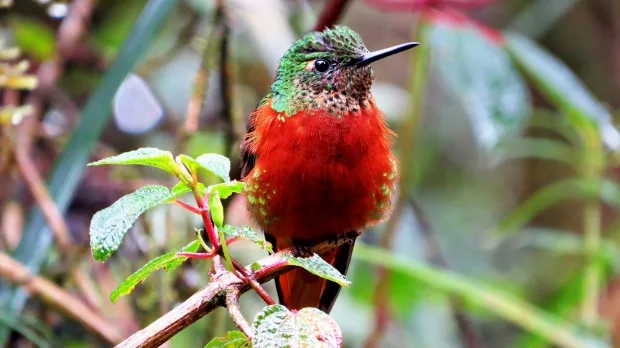Studies in Ecuador, other South American countries, reveal the strange drinking habits of hummingbirds
Hummingbirds are named for the sound of their rapidly beating wings, but now their tongues have captured scientists’ attention.

This little guy is drinking more than you might think.
These tiny birds can suck 10 drops of nectar out of a flower every 15 milliseconds, researchers at the University of Connecticut recently discovered. For nearly two centuries, scientists have thought the birds used a much slower “wicking” technique (absorbing or drawing off a liquid by capillary action), LiveScience reported.
It turns out that hummingbird tongues do not wick, they pump.
By capturing video footage of 18 species of hummingbirds drinking from artificial “flowers,” the research team, led by research scientist Alejandro Rico-Guevara and mechanical engineering associate professor Tai-Hsi Fan, found that the birds’ tongues have tube-like grooves that rest in a collapsed state, but open and fill with nectar upon contact with flowers.
“The tongue works as an elastic micropump; fluid at the tip is driven into the tongue’s grooves by forces resulting from re-expansion of a collapsed section,” the report says.

The Chestnut Breasted Coronet, found in Ecuador and Colombia.
The study’s methodology surpasses that of previous hummingbird research, Professor Rubega said in a university news release, because it comes closer than ever to approximating real-life conditions.
In previous studies, captive birds sipped nectar from feeders in laboratories containing far more liquid than a real flower. This time, scientists filmed wild hummingbirds feeding from transparent feeders that mimic the shape, nectar amounts, and calorie concentrations of hummingbirds’ favorite flowers.
The study has yielded the largest data set of any hummingbird study to date, the result of five years’ work. Dr. Rico-Guevara told LiveScience that building the transparent “flowers” was a challenging but essential part of the research, since “when the [hummingbird’s] bill goes inside a flower, you don’t see what is happening inside at all.” The design used transparent tubes filled with artificial nectar, with cameras set up nearby.
The study was conducted in a number of locations across the Americas, including Connecticut, Texas, California, Ecuador, Brazil, and Colombia, they gathered footage of 32 different birds from 18 different species. Most of video was shot in Ecuador, in the cloud forest north of Quito.
The next challenge was observing different species of hummingbirds. The only hummingbird found east of the Mississippi is the Ruby-throated Hummingbird, so the researchers had to go further afield to gather a broad sample.
“I tried to get as many different kinds of hummingbirds as possible,” Rico-Guevara told LiveScience. “Not just to get different species, but [also] the crazy ones, the extreme ones, just to be able to generalize what happens.”
The discovery of the micro-pump method of feeding may lead scientists to revisit previous hummingbird research, Rico-Guevara said. Earlier studies indicate that some flowers produce diluted nectar, which would be helpful for hummingbirds feeding using capillary “wicking” as previously assumed, but which is unnecessary for micro-pump feeding.
The new study was published Wednesday in Proceedings of the Royal Society B: Biological Sciences. “Our research shows how they really drink and provides the first mathematical tools to accurately model their energy intake,” Rico-Guevara said in the news release, “which will in turn inform our understanding of their foraging decisions and ecology.”
_____________
Credit: Christian Science Monitor
















